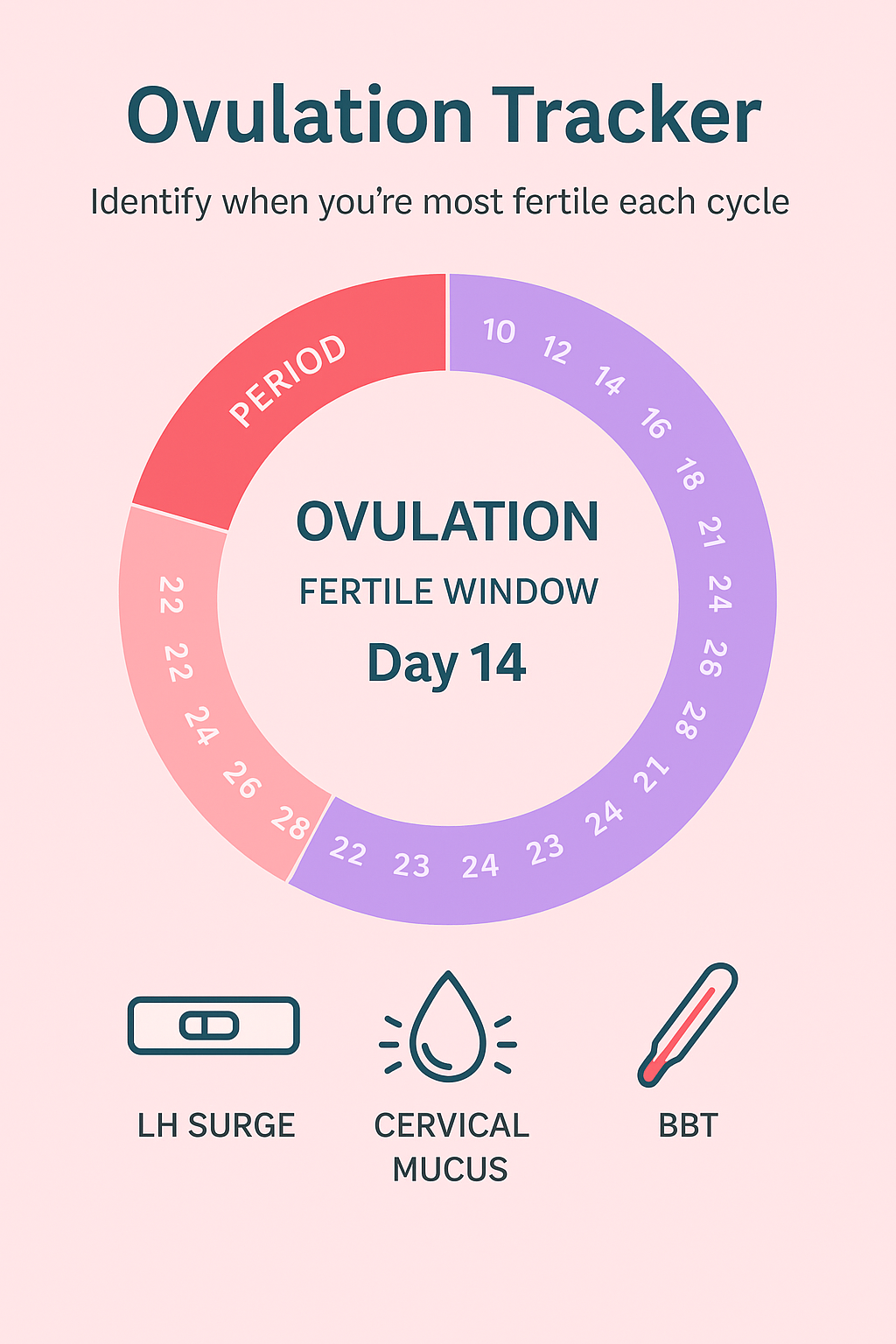Ovulation Tracker: Understanding Your Fertile Window for Successful Conception
Category: Fertility & Conception Planning | Goal Type: OvulationTracking
Tags: OvulationTracking, FertileWindow, CycleTracking, ConceptionSuccess, FertilityTips, CycleHealth, LifestyleForConception, SupplementsForConception, FertilityBoost, FertilityJourney, SelfMonitoring, HealthTests
Planning for pregnancy begins with understanding your ovulation cycle. The Ovulation Tracker in HealthTrack helps you visualize your body’s natural rhythm, identify the fertile window, and make confident, data-based decisions about conception timing. Whether you’re starting your conception journey or optimizing your fertility, this tracker simplifies the process using accurate insights.
What Is Ovulation?
Ovulation is when a mature egg is released from the ovary and becomes available for fertilization. This usually occurs midway through your cycle—around Day 14 in a 28-day cycle—but can vary. Tracking your ovulation helps identify when you are most fertile, increasing the chances of natural conception.
How the Ovulation Tracker Works
- Cycle Monitoring: Logs your menstrual and ovulation patterns to learn your typical cycle length.
- LH Test Integration: Detects luteinizing hormone surges that signal ovulation 24–36 hours in advance.
- BBT (Basal Body Temperature): Tracks small temperature increases after ovulation to confirm its occurrence.
- Cervical Mucus Tracking: Identifies fertile-quality mucus — clear, stretchy, and slippery — that indicates peak fertility.
- Fertility Insights: Combines hormonal, physical, and behavioral data for accurate cycle predictions.

Understanding the Fertile Window
Your fertile window spans approximately six days: the five days before ovulation and the day of ovulation itself. Sperm can survive up to five days in the reproductive tract, while the egg lives for 12–24 hours after release. Logging data consistently ensures that HealthTrack accurately predicts your most fertile period each cycle.
| Cycle Day | Fertility Phase | Action |
|---|---|---|
| 1–5 | Menstrual Phase | Rest, track bleeding flow and pain levels. |
| 6–10 | Follicular Phase | Prepare body with healthy meals and hydration. |
| 11–15 | Fertile Window & Ovulation | Track LH surge and cervical mucus; plan intercourse. |
| 16–28 | Luteal Phase | Monitor BBT rise, mood, and early pregnancy signs. |
Supporting Fertility Naturally
- Balanced Diet: Include leafy greens, lean protein, whole grains, and omega-3s to support ovulation health.
- Hydration: Drink 2–3 liters of water daily to improve cervical mucus quality.
- Sleep & Stress: Get 7–9 hours of rest; stress hormones can delay ovulation.
- Exercise: Moderate movement (yoga, walking) helps regulate hormones without overexertion.
- Folic Acid: Begin prenatal vitamins at least 1–3 months before conception.
How to Read Your Tracker Insights
Each cycle is unique, so the more you log, the smarter your tracker becomes. When you see a predicted fertile window, plan intimacy every 1–2 days for the best chance of success. Over several cycles, your tracker refines predictions using your body’s specific hormone patterns.
When to Seek Medical Advice
- If cycles are consistently shorter than 21 or longer than 35 days.
- If you’ve been trying to conceive for over 12 months (6 months if over 35).
- If you have missed periods, severe cramps, or irregular bleeding.
- If diagnosed with PCOS, endometriosis, or thyroid issues.
A doctor can perform fertility tests such as hormone panels, ultrasounds, and reproductive health screenings to guide you further.
FAQ: Ovulation & Conception Tracking
1. Can I rely on calendar predictions alone?
No. Calendar methods estimate averages but don’t reflect hormonal variations. Tracking LH and mucus gives more precise results.
2. Do stress or diet affect ovulation?
Yes. Stress and poor nutrition can delay or suppress ovulation. Prioritize balance and mindfulness for regular cycles.
3. Can I use this tracker if I have irregular cycles?
Yes. The tool learns from your data over time, focusing on LH, BBT, and symptoms rather than fixed day counts.
4. Does basal body temperature confirm ovulation?
Yes. A sustained rise of 0.2–0.5°C after ovulation confirms it has occurred.
Key Takeaways
- Track ovulation using multiple signs: LH, BBT, and cervical mucus.
- Plan intercourse during the fertile window for the best chances of conception.
- Support reproductive health with sleep, nutrition, and stress care.
- Seek professional evaluation if cycles are irregular or conception takes longer than expected.


